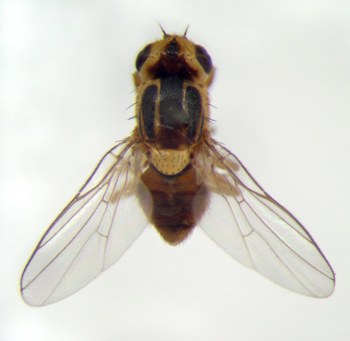Pests
Chlorops pumilionis Bjekander - Chloropid Gout Fly
Systematic position.
Class Insecta, order Diptera, family Chloropidae, genus Chlorops.Synonym.
Chlorops taeniopus MeigenBiological group.
This is an oligophagous pest of cereals.Morphology and biology.
Body of the fly is light-yellow, with three big longitudinal nodal stripes, with small black triangular spot on head. Its length varies from 3 to 5 mm. Eyes are bright-green. Third antennal segment and two last segments of tarsus are black. White egg is covered with longitudinal costulae. Cylindrical cream-colored larvae reach up to 7 mm. Last segment has two tubercles. Body length of narrow cylindrical light-yellow puparia is about 6 mm. Over-wintering takes place during the larval phase of I-III instars inside stems of winter cereals and wild cereal grasses. During spring the larvae feed and then pupate. Spring pupa lives 25-33 days. Emergence of flies is observed in the second half of May or in the beginning of June. Flies fly out, sexually mature, feeding on pollen and nectar of wild plants; in a few days they begin to lay eggs. Oviposition lasts 19-23 days. Females live 29-43 days, laying 87 to 135 eggs in drops of liquid excretions on lower side of upper leaves. The 2-3 leaf growth stage on spring cereals is the most favorable for oviposition. Embryonic development lasts 6-8 days. Larvae penetrate behind the leaf sheath, feed there and make an oblong furrow from ear base toward upper node. Larval period lasts 21-26 days. Pupation is observed in feeding places. Summer pupae live 12-19 days. Emergence of flies occurs at the end of July or in the beginning of August, oviposition takes place in the first half of August and lasts until mid-October. Insects lay eggs on young winter cereals and wild grasses. Flies of second generation live 2-2.5 months. Life span of the insects of first generation is about 36-53 days, and that of the second generation is 43-59 days.Distribution.
The insect is widespread in South, North, Central Europe, North America, Africa, and Japan. Within the territory of the Former Soviet Union the species occurs widely up to 65°N and to southernmost points. It is found in Siberia, Primorskii Territory and Altai. Its high harmful activity occurs in North-Western region of the European part of Russia, in Central part of Non-Black Earth zone, in Baltic States, Byelorussia; periodically in the Caucasus, Transcaucasia (where the summer diapause takes place).Ecology.
The insect is moderately cold-resistant. Mass destruction of wintering larvae is observed at temperatures of -25°C and lower. Pupation in the spring generation occurs with the air temperature 14-15°C and relative humidity 75-100%. Lower temperature threshold of the Gout Fly is about 8-10°C, upper one is 32°C. At the temperature 25-26°C and higher the pest goes into summer diapause. It is strongly hygrophilic. Flies begin wintering at the temperature 8-10°C. The insect is bivoltine. Most important predators are: Stenomalus micans Oliv., S. laetus Rushka, Eupelmus microcinus Forst., Coelinius niger Nees., Rhogas circumscriptus Nees.Economic significance.
The Gout Fly damages 18 species of cultivated and wild cereal plants, such as winter and spring wheat, winter and spring barley, rye, oats, timothy-grass, couch-grass. In some cases the insect prefers wheat, in other, barley. Two types of damage are known. The first type appears with a late sowing date. Larvae injure young tissues of plants, including growing points. The stem deforms, internodes stop growing, ear does not emerge. When seed is sown at an earlier date, ear emergence takes place. Reaching young ears, the larva comes down to its base and eats slender parts. A brown furrow is observed in ear and ear pedicle. Control measures include early dates of sowing, using varieties that have fast ear emergence, stubbling and burning-out of stubble, eradication of weeds, deep autumn plowing, and insecticide treatments during oviposition period.Reference citations:
Alkhazishvili T. 1954. Materials to studying of chloropid gout fly (Chlorops pumilionis Bjerk.). Proceedings of Georgian plant protection institute. V. 10. Tbilisi: Georgian plant protection institute. 50-53 p. (In Russian)Ovchinnikova M.I. 1927. Results of observations and experiments on chloropid gout fly (Chlorops taeniopus Meig.) during 1924-1926 in Nizhnii Novgorod Region. In: Bogdanov-Kat'kov N.N., ed. Plant protection from pests. V. 4. Leningrad: Plant protection service. 655-717 p. (In Russian)
Prutskov F. 1966. Damage of cereals by chloropid gout fly. Zashchita rastenii 3: 26. (In Russian)
Sinitsina L.P. 1960. Biological features of chloropid gout fly Chlorops pumilionis Bjerk. and conditions regulating its distribution and harmful activity in different parts of area. PhD Thesis. Leningrad: Zoological Institute. 23 p. (In Russian)
Zhabinskaya M.I. 1961. Vital cycle of chloropid gout fly (Chlorops pumilionis Bjerk.) and its host plants. In: Shempel' V.S., Semenov A.L., Prokopov P.E., Strelkov I.G., eds. Proceedings of Byelorussian institute of agriculture. V. 7. Minsk: Byelorussian institute of agriculture. 365-377 p. (In Russian)


